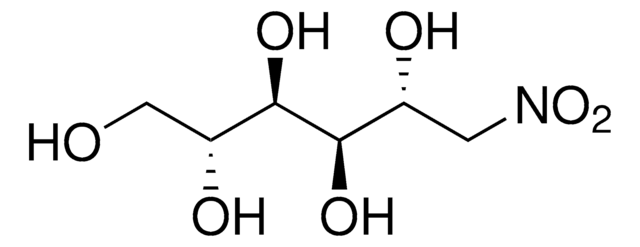Products may be shipped at a different temperature than the recommended long-term storage temperature. If the product quality is sensitive to short-term exposure to conditions other than the recommended long-term storage, it will be shipped on wet or dry-ice. If the product quality is NOT affected by short-term exposure to conditions other than the recommended long-term storage, it will be shipped at ambient temperature. As shipping routes are configured for minimum transit times, shipping at ambient temperature helps control shipping costs for our customers. For more information, please refer to the Storage and Transport Conditions document: https://www.sigmaaldrich.com/deepweb/assets/sigmaaldrich/marketing/global/documents/316/622/storage-transport-conditions-mk.pdf
Select a Size
Select a Size
About This Item
Recommended Products
biological source
plant
Quality Level
Assay
≥98% (GC)
form
powder
color
white
useful pH range
5.0-6.5 (25 °C, 182 g/L, (77 °F ))
mp
167-170 °C (lit.)
solubility
water: 100 mg/mL, clear, colorless
storage temp.
room temp
SMILES string
OC[C@@H](O)[C@@H](O)[C@H](O)[C@H](O)CO
InChI
1S/C6H14O6/c7-1-3(9)5(11)6(12)4(10)2-8/h3-12H,1-2H2/t3-,4-,5-,6-/m1/s1
InChI key
FBPFZTCFMRRESA-KVTDHHQDSA-N
Looking for similar products? Visit Product Comparison Guide
General description
Application
- in osmotic loading to adjust the osmolarity of solutions
- as a component of test sugar solution for cellobiose-mannitol permeability test
- as an internal standard in nuclear magnetic resonance (NMR) to compare/analyze the mannitol concentrations in urine samples
- to treat the control cells and regulate the osmotic pressure of high glucose
Biochem/physiol Actions
Other Notes
Storage Class Code
11 - Combustible Solids
WGK
WGK 1
Personal Protective Equipment
Choose from one of the most recent versions:
Certificates of Analysis (COA)
Don't see the Right Version?
If you require a particular version, you can look up a specific certificate by the Lot or Batch number.
Already Own This Product?
Find documentation for the products that you have recently purchased in the Document Library.
Customers Also Viewed
-
How is shipping temperature determined? And how is it related to the product storage temperature?
1 answer-
Helpful?
-
-
How can I determine the shelf life / expiration / retest date of this product?
1 answer-
If this product has an expiration or retest date, it will be shown on the Certificate of Analysis (COA, CofA). If there is no retest or expiration date listed on the product's COA, we do not have suitable stability data to determine a shelf life. For these products, the only date on the COA will be the release date; a retest, expiration, or use-by-date will not be displayed.
For all products, we recommend handling per defined conditions as printed in our product literature and website product descriptions. We recommend that products should be routinely inspected by customers to ensure they perform as expected.
For products without retest or expiration dates, our standard warranty of 1 year from the date of shipment is applicable.
For more information, please refer to the Product Dating Information document: https://www.sigmaaldrich.com/deepweb/assets/sigmaaldrich/marketing/global/documents/449/386/product-dating-information-mk.pdfHelpful?
-
-
What is the particle size on this product? Looking for a larger particle size 100-250um
1 answer-
Unfortunately, the particle size is not determined for this product.
Helpful?
-
-
IS IT TESTED ON ANIMAL CELL CULTURE
1 answer-
This product has not been tested with mammalian cell culture. It is cited to have been used in primary retinal cell culture.
Kindly review the following publication: Trotta MC, Pieretti G, Petrillo F, Alessio N, Hermenean A, Maisto R, D'Amico M. Resolvin D1 reduces mitochondrial damage to photoreceptors of primary retinal cells exposed to high glucose. J Cell Physiol. 2020 May;235(5):4256-4267. doi: 10.1002/jcp.29303. Epub 2019 Oct 14. PMID: 31612492.In addition, product M1902 has been tested for use in plant culture and product 63560 has been tested for use in microbiology. See the links below to review each product.
M1902
https://www.sigmaaldrich.com/product/sigma/m1902
63560
https://www.sigmaaldrich.com/product/sial/63560Helpful?
-
-
Hi! Is this product safe to use in studies for animals?
1 answer-
This product is intended for research use only. Currently, no D-Mannitol product is offered that is tested for in vivo or in vitro use.
For use in animal models, product M8429 may be a more suitable option. While still a research-grade reagent, this product meets USP, EP, and FCC specifications.Please see the link below to review this product option:
https://www.sigmaaldrich.com/product/sial/m8429In either case, the end user would have to determine suitability.
Helpful?
-
-
I have a question about mannitol (as an excipient in a medicinal product). The questions would be the following: Is mannitol absorbed at intestinal level? Do you know about a possible interaction between mannitol and disulfiram? Thank you.
1 answer-
Please note, unless otherwise stated, this product is intended for research purposes only and not for use as a drug to be administered to animals or humans.
The in vivo metabolism of this product has not been evaluated. However, certain publications show that mannitol is absorbed by the small intestine.
The link below may provide helpful information:
https://www.ncbi.nlm.nih.gov/pmc/articles/PMC2802677/Helpful?
-
Active Filters
Our team of scientists has experience in all areas of research including Life Science, Material Science, Chemical Synthesis, Chromatography, Analytical and many others.
Contact Technical Service



